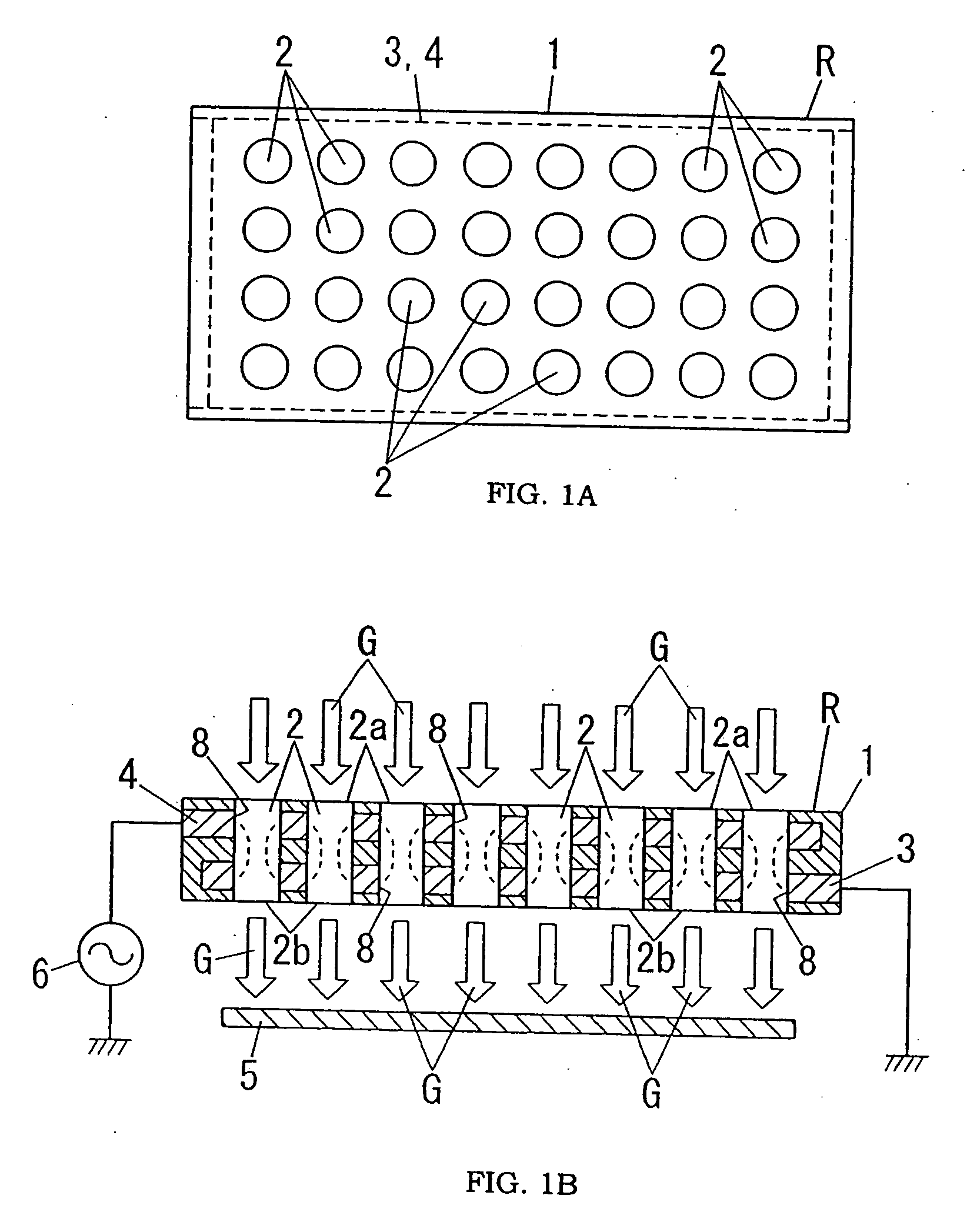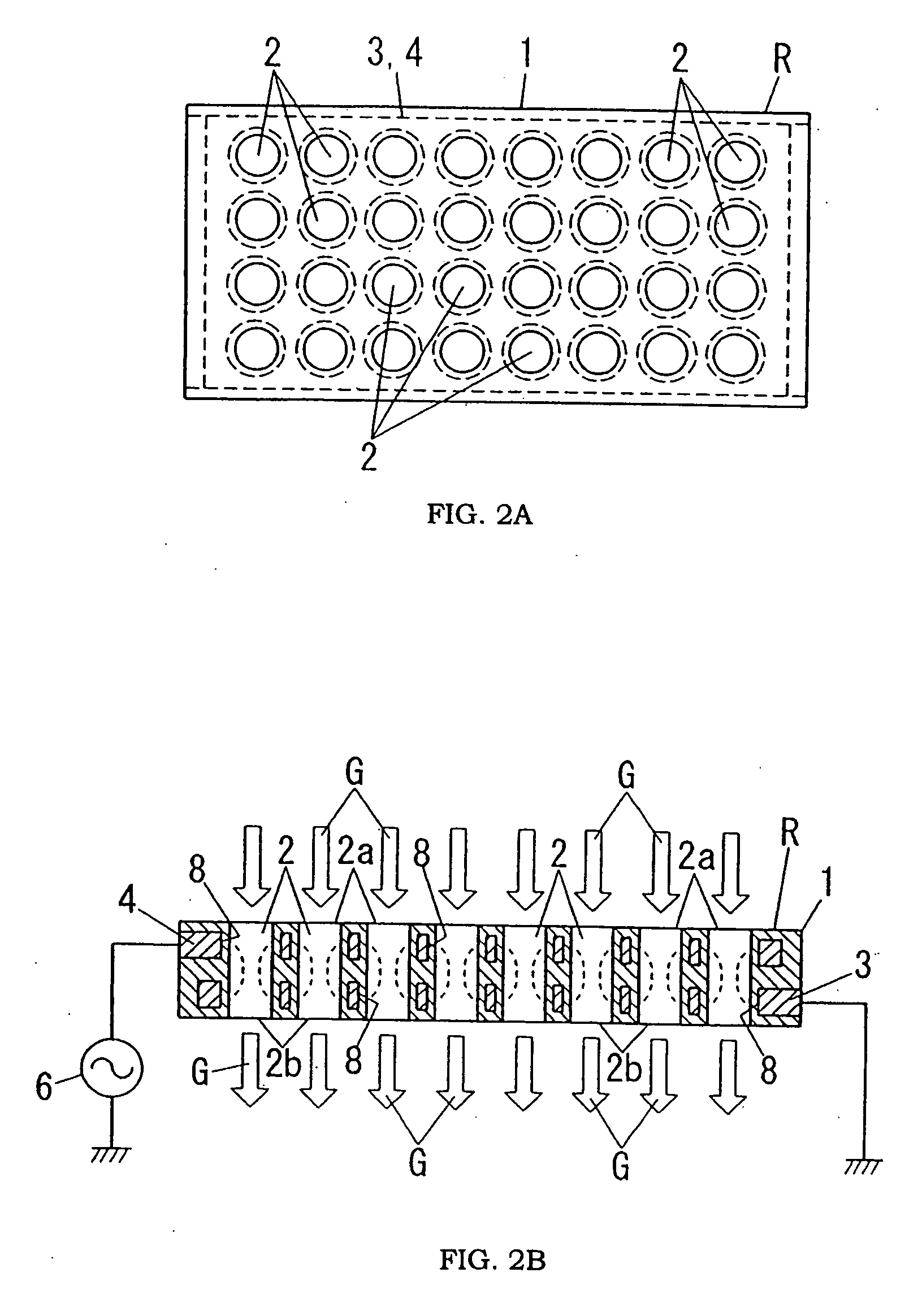Plasma treatment apparatus, method of producing reaction vessel for plasma generation, and plasma treatment method
a technology of plasma treatment apparatus and reaction vessel, which is applied in the field of plasma treatment apparatus and method, can solve the problems of easy variation of treatment effect on objects, increase in running cost, etc., and achieve the effects of increasing the treatment area, small gas consumption, and high degree of freedom in design
- Summary
- Abstract
- Description
- Claims
- Application Information
AI Technical Summary
Benefits of technology
Problems solved by technology
Method used
Image
Examples
example 1
[0122] An electrically conductive film was formed on a surface of a first sheet (thickness: 0.4 mm) by printing, and then a second sheet (thickness: 1.4 mm) was placed on this electrically conductive film. In addition, an electrically conductive film was formed on a surface of the second sheet by printing, and then a third sheet (thickness: 1.4 mm) was placed on this electrically conductive film. In this embodiment, each of the first to third sheets was obtained by molding a material containing an alumina powder into a sheet shape. Each of the sheets has a plurality of apertures each having a diameter of 1 mm. These sheets were disposed in layers such that positions of the apertures of the respective sheets corresponds to each other. The electrically conductive film was formed by printing a tungsten layer. A plurality of apertures 8 each having a diameter of 3 mm larger than the aperture of the sheets were formed in the electrically conductive film such that each of the apertures of...
example 2
[0125] An electrically conductive film was formed on a surface of a first sheet (thickness: 0.7 mm) by printing, and then a second sheet (thickness: 1.5 mm) was placed on the electrically conductive film. Each of the first and second sheets was formed by molding the material containing alumina into a sheet shape, as in the case of Example 1. Each of the first and second sheets has a plurality of slit-like apertures each having a width of 1 mm and a length of 22 mm in a plan view thereof. These sheets were disposed in layers such that positions of the slit-like apertures of the respective sheets corresponds to each other. The electrically conductive film was formed by printing a tungsten layer, as in the case of Example 1. In this embodiment, each of the electrically conductive films was formed in a comb-shaped pattern. The thus obtained laminate was sintered to obtain a reaction vessel R having a structure shown in FIGS. 3A and 3B.
[0126] In this embodiment, an insulting member 1 of...
example 3
[0128] A plasma treatment apparatus used in this embodiment is substantially the same as the apparatus of Example 1 except that the diameters of the apertures 8 of the electrodes 3, 4 and the through holes 2 are 1 mm, and inner surfaces of the apertures 8 of the electrodes 3, 4 are exposed to the interiors of the through holes 2, as shown in FIG. 10.
PUM
| Property | Measurement | Unit |
|---|---|---|
| diameter | aaaaa | aaaaa |
| frequency | aaaaa | aaaaa |
| inner diameter | aaaaa | aaaaa |
Abstract
Description
Claims
Application Information
 Login to View More
Login to View More - R&D
- Intellectual Property
- Life Sciences
- Materials
- Tech Scout
- Unparalleled Data Quality
- Higher Quality Content
- 60% Fewer Hallucinations
Browse by: Latest US Patents, China's latest patents, Technical Efficacy Thesaurus, Application Domain, Technology Topic, Popular Technical Reports.
© 2025 PatSnap. All rights reserved.Legal|Privacy policy|Modern Slavery Act Transparency Statement|Sitemap|About US| Contact US: help@patsnap.com



